
All Rights Reserved by the Blow Torch Collectors Association 2015

BTCA: Blow Torch Collectors Association: Founded 1995
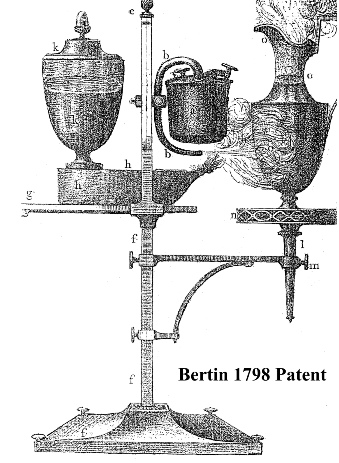
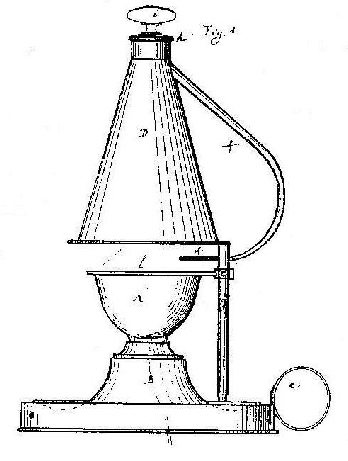
A Short History of Blowtorches.
Few collectors realize that in one form or another, blowtorches have been around for about two hundred years. (Actually, mouth or bellows activated blowpipes go back at least a couple of thousand years!) Many collectors have accumulated torches that are at least a hundred years old and may not even realize it, so it is worthwhile to summarize the history.
Beginnings 1799 -
The man credited with creating the very first self-
Bertin placed a sealed container of liquid above the flame from a lamp, and used the pressure generated by expansion of vapor in the upper container to create a blast via a pipe with a fine jet pointed though the flame below. Blowtorches based on Bertin’s principle would continue in use for more than a hundred years.
The French term for the early blowtorch was “éolipyle”, a word that is still used today by French collectors of blowtorches. A dictionary definition is: “a device based on the effect of forces produced by a jet of gas, from the Latin Aeoli pylae, literally “Aeolus” doorway.” Aeolus was the Greek god of the winds.
For much of the earliest history, we rely on patents from France, the USA and from other countries.
Another Frenchman, Maurice Antoine Dunand, improved upon Bertin’s "éolipyle" with an 1844 patent in which the components of the earlier invention were combined in a self-
America 1850 -
In the years before and after the American Civil War, American inventors improved upon the French ideas. Oliver L. Lawson’s patent, dated May 13, 1856, referred to other similar and earlier blowpipes. Although the inventor did not identify these earlier innovations, the principles of operation were clearly European in origin. Lawson used a jet of steam to blow the flame and he regulated the flame by adjusting the flow of steam with a thumbscrew. He also added a safety valve.
The first American inventions of hand-
Shown below are the Lawson, Wakeman and Wanier patent illustrations.
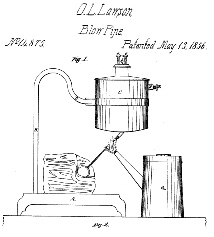
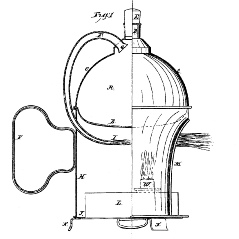
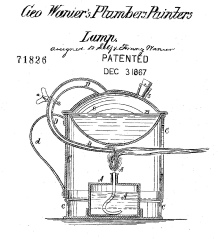
1866 -
The authors ascribe the title, “Father of the American Blow Torch” to John Summerfield Hull, who worked in Cincinnati, OH and later in Baltimore, MD. His inventions from 1866 through 1878 demonstrate a progression of principles, which combine to make a single, hand-
1880 -
In the decade of the 1880’s, the American blowtorch assumed a shape that would not change radically during the next seventy-
One noteworthy innovation was the Butler patent of 1889, which introduced an external pipe connection from the base of the pump-
1890 -
The three companies, which were to dominate the blowtorch business from the beginning of the twentieth century until the 1960’s became active in the manufacture of torches in the 1890’s.
Three brothers named Lambert started the Clayton & Lambert Co. in Ypsilanti, MI in 1882. In 1887, John N. Clayton, who had invented a burner for a plumbers’ furnace, joined the brothers. By the 1890’s Clayton’s burner was applied to a paint-
Otto Bernz founded his company in Newark, NJ to manufacture tools and supplies for plumbers. By the turn of the century, Bernz had added blowtorches and furnaces and built up a successful business selling both product lines under the Bernz name, and as a contract manufacturer for some of the large department and mail order stores.
The Turner Brass Works originally made harness and saddle fittings, as well as components for bicycles. By the 1890’s, Turner was making blowtorches, and its merger with another Chicago torch maker, the White Mfg. Co., led to Turner becoming the largest of all the blowtorch makers.
1900 -
Between 1900 and 1920, more companies established themselves as blowtorch suppliers. Some of the bigger names were Ashton Mfg., Detroit Torch & Mfg., George Diener Co., and Shapleigh Hardware. The Hauck Mfg. Co. created a very distinctive line of larger and industrial torches.
Several European companies marketed torches in the USA starting in the late 1890’s. By the early 1900’s, Primus, Sievert, Optimus, and Barthel all had their own offices in the USA.
1920 – 1970
During the 1920’s and 1930’s, companies such as Unique Mfg., Brookins and Downey Mfg. entered the business with very distinctive offerings.
The blowtorch business remained strong through the Second World War, but changes in technology were ahead. The final demise, by 1970, of gasoline and kerosene torches came with the introduction of propane blowtorches in the 1950’s, coupled with the advent of plastic water pipes.
Furnaces, from 1877
The development of plumbers’ firepots, furnaces and soldering iron heaters roughly paralleled the introduction of blowtorches. Plumbers and roofers were dependent upon charcoal-
By the turn of the century, the major blowtorch suppliers also offered a line of firepots and furnaces, and one company, J. Burgess & Sons of Columbus, Ohio, specialized in distinctive soldering iron heaters.
Self-heated soldering irons (SHSI) and branding irons, from 1890
Starting around 1890, more than one hundred US patents were issued for self-
Alcohol torches, from 1895
An early use of small alcohol blowtorches was in dental and other laboratories, as well as by jewelers. In 1895, the Taylor tubular torch was invented, from which the “Victor” torch evolved, and in 1899, the Roberts patent was issued for an alcohol torch. Four companies, McGill Co., Zeidler Co., Ransom & Randolph and the Crescent Co., commercialized the “Baby” design, invented in 1903. In 1908, Francis B. Carleton patented the “Imp” torch, which would be sold under the Scovill, Lenk, and Bernz names, in addition to Carleton’s own company. In 1921, Carleton patented the “Spartan” torch, which was to be made by several manufacturers.
In the 1920’s, small alcohol torches were in great demand by amateur radio builders. Across America, as radio stations went on the air, starting in about 1920, a majority of receiving sets were built at home from kits or plans, in many cases by boys. In rural America, in towns that did not yet have electric power distribution, the sets could work from batteries, but electric soldering irons would not work. The advertising material for some of the early alcohol torches was specifically directed at homebuilders of radio sets.
The Lenk Manufacturing Co. got its start in 1920, manufacturing the “Imp” and “Spartan” torches patented by Carleton in 1908. Lenk would later undertake its own innovations and designs.
In 1926, Lester Lasher received the first of several patents for alcohol blowtorches. His inventions led to the “Jim Dandy” line of blowtorches, which were most successfully commercialized by Modern Metal Products.